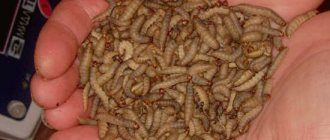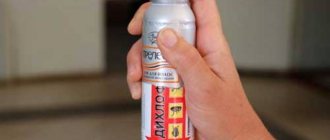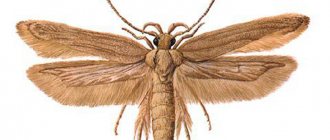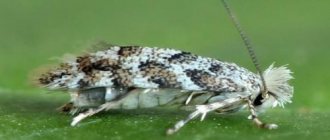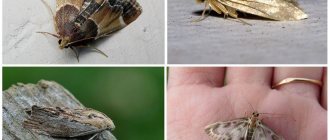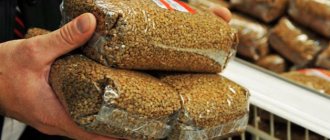Many beekeepers and avid beekeepers know that wax moths are one of the main pests of honeycombs for bees. However, this individual also has useful properties. Fireweed is used to create medicines that have been extremely popular in folk medicine since ancient times. Even in Ancient Egypt and Greece, the valuable qualities of such a pest were known.
Wax moths and their larvae serve as raw materials for the manufacture of special traditional medicine. It can be prepared at home using a special recipe. Wax moth larvae can be used to make various preparations suitable for the treatment of many diseases. Forms of medicinal raw materials:
- extract;
- ointment;
- alcohol tincture;
- water infusion.
Healing properties
Preparations created from wax moth larvae, namely ointments, infusions and extracts, have unique medicinal properties, for example:
- have an antibacterial as well as antiviral effect;
- improve blood circulation, help improve metabolism in the human body;
- help to resolve scars after a heart attack;
- stimulate the functioning of the immune system;
- stimulate testosterone production in men with reduced libido;
- normalize sound and healthy sleep, and also improve the condition of the nervous system;
- used in the treatment of the male prostate, have a positive effect on the human reproductive system;
- increase mental activity and improve brain processes;
- restore muscles after heavy loads.
If you follow the instructions for use, you can quickly relieve unpleasant symptoms and recover from many diseases. Please consult your doctor before use.
Method for obtaining a biologically active product from wax moth larvae
DESCRIPTION OF THE INVENTION to the patent of the Russian Federation (21)4938002/14 (22) 2603.91 (46)2706.95 Bulletin No. 18 (71) Institute of Theoretical and Experimental Biophysics of the USSR Academy of Sciences (72) Spiridonov NA; Rachkov AK; Mukhin SA; Kondrashova M.N. (73) Spiridonov Nikolay Alekseevich (55) Copyright certificate of the USSR N 1284229, hl. A 61K 35/04. 1989. The invention relates to biology and pharmacology. The purpose of the invention is to obtain from the larvae of the greater wax moth a standardized biologically active product with a biostimulating, adaptogenic and cardioprotective effect based on low-active products of the bee colony. To do this, extraction of the biologically active product is carried out with 40% ethanol from moth larvae of the last instar weighing 150 mg or more, grown outside the hive on dark waxy dry land, at 20 -25 ° C, in the dark, for 20 days until complete extraction of the product.
The invention relates to biology and pharmacology and can be used to obtain a biologically active product from wax moth larvae. The large wax moth Galleria mellonella L (Lepidoptera, Pyralldae, hereinafter referred to as wax moth) is a widespread parasite of the bee colony. Wax moths are bred and used for various purposes: as a laboratory host for growing entomophagous insects used for biological protection of plants in agriculture; as a test object for assessing the activity and quality of bacterial preparations; and also as an object of biochemical and physiological research in entomology.
To grow wax moths in laboratory conditions, honeycombs, flower pollen, pollen with beeswax additives, as well as artificial nutrient media of various compositions are used as food. The most convenient and widely used for mass rearing of insects is an artificial medium with the addition of beeswax and honey, developed by Marston and co-authors and modified by Yu.I. Kuznetsova. In laboratory conditions, wax moths are grown in Petri dishes, glass jars equipped with lids with a fine mesh sealed mesh. For mass breeding of insects, special containers are used.
There is a known method for isolating from wax moths a preparation of lipases, which are digestive enzymes of insects that have an antimicrobial effect against Mycobacterium tuberculosis. To do this, wax moth larvae collected in a bee hive are ground and dried using the Willstatter method, then lipases are extracted from the resulting powder with an emulsifying mixture containing 50% glycerol and 1.5% carboxel, then the lipases are precipitated with acetone and subjected to lyophilization.
The disadvantage of this method is the limited spectrum of biological activity of the resulting drug. There is a known method for obtaining an extract from wax moth that has a growth-stimulating effect on lymphoblastoid cells of the Raj line in culture. According to the method, wax moth larvae collected in a beehive are subjected to extraction with 40% ethanol at 20-25°C in the dark for 20 days. The disadvantage of this method is the impossibility of obtaining significant quantities of the drug due to the economic inexpediency of breeding wax moth larvae in a beehive, which leads to the weakening and death of the bee colony. In addition, the method does not provide a product that is reproducible in terms of biological activity due to the uncontrollability of the conditions for growing the larvae and the food they absorb. Other methods for obtaining biologically active drugs from wax moth larvae are not known from the literature.
The purpose of the present invention is to increase the yield and stabilize the biological activity of the product, as well as having an adaptogenic, cardioprotective effect.
To do this, the method, which includes the extraction of wax moth larvae, involves growing the larvae outside the hive, and using dark waxy sushi containing the products of the long-term vital activity of the bee colony as food.
The invention is based on the first discovered and studied biological properties of dark waxy sushi, which is a product of many years of activity of a bee family. Dark waxy dryness is formed from bee honeycombs after the last few generations of bee brood have been raised for 3-4 years. In terms of its chemical composition, it differs significantly from honeycombs, light wax drying and purified wax, traditionally used for growing wax moths. Dark wax drying contains a smaller amount of wax compared to light drying (40-55% instead of 70%, with a humidity of 2.2-3.8% instead of 01.-0.5%). It has been established that, in addition to wax, it contains waste products of bees (royal jelly residues, larval membranes, bee brood integuments, carbohydrates, peptides, nitrogen-containing substances, serotonin - similar compounds), as well as flavonoids and aromatic acids of plant origin. The presence of these components makes dark wax dry a complete nutrient medium for wax moth larvae and allows you to do without the use of pollen, honey and other expensive food additives. It has also been established that dark waxy dryness, which in itself does not have significant biological activity, undergoes metabolic transformation by wax moth larvae and turns into a biologically active product with a wide spectrum of action.
The product obtained by the proposed method contains several biologically active components. Its chemical composition differs from the composition of the extract obtained in a similar way from wax moth larvae grown on artificial food, as well as from the composition of the dark wax sushi extract.
Studies conducted on various biological models have shown that the extract of wax moth larvae obtained by the proposed method has a wide spectrum of biological activity, adaptogenic, growth-stimulating and cardioprotective effects, and also stimulates the oxidative metabolism of cardiac and vascular tissues.
At the same time, the extract obtained from wax moth larvae grown on artificial food, as well as the extract of dark wax sushi, do not exhibit biological activity.
Unlike the well-known preparation of lipases from wax moth larvae (analogue), the product obtained by the proposed method does not have an antimicrobial effect against Mycobacterium tubereulasis and other microorganisms.
Below is a specific example of the implementation of the proposed method. Biological material for wax moth breeding (eggs, larvae, cocoons, butterflies) was collected from apiaries in the summer. The insect was identified using the reference book of diseases and pests of bees. Subsequently, constant cultivation of wax moths was carried out in laboratory and production conditions.
To grow wax moth larvae, a container measuring 30x30x40 cm was used, equipped with a lid and a ventilation slot covered with a fine-mesh metal mesh with a hole size of less than 1 mm. 500 g of dark wax sushi (dark brown and black in color, non-transparent at the bottoms, containing 40-55% wax with a humidity of 2.2-3.8%) and a clutch of wax moth eggs (about 500 eggs) were placed in the container. The larvae were reared at 20-25°C and relative humidity 60% for 35 days. For extraction of biologically active substances, larvae that reached the last stage of development before pupation, weighing 150 mg or more, were selected. Selected larvae (100 g) were placed in a wide-necked vessel, and the cobwebs and remains of waxy dry land were removed. Then the larvae were transferred to a 600 ml extraction vessel with a ground glass stopper and 450 ml of 40% rectified ethyl alcohol was added. Extraction was carried out at 20-25°C in the dark with periodic stirring for 21 days until complete extraction of the product. The extract was then filtered through a paper filter. We received 420 ml of extract. The resulting product is a transparent liquid of reddish-yellow color, containing about 1% dry matter and having characteristic fluorescence (440 nm at an exciting light wavelength of 350 nm). The extract was stored in the dark at 4°C, and the biological activity remained for a year.
Study of the chemical composition of the resulting product. The chemical composition of the resulting product was studied by various biochemical methods using thin layer chromatography, gas chromatography, disk electrophoresis, amino acid and elemental analysis, NMR, UV and luminescence spectroscopy. Fractionation of the product was carried out on a column with Sephadex LH-20.
The following components were found in the product: - proteins and peptides (2% dry matter), including acidic peptides containing an associated aromatic component, as well as alkaline serine protease (fraction 1); - free amino acids (50-60% dry matter), (fractions 2-5, table 1); — low-molecular growth-stimulating factor (fraction 3); — low-molecular aromatic compounds (fraction 7); — lipids, including fatty acids (Table 2); -carbohydrates.
At the same time, an extract of larvae grown on the medium developed by Marston and co-authors and modified by Yu.I. Kuznetsova was prepared using the same method. The medium contained the following components (g/kg): bran - 100, wheat flour - 110, corn fly - 140, yeast - 130, milk powder - 130, glycerin - 210, honey - 100, wax - 80. We obtained a product that is a transparent liquid of light yellow color, containing about 1% dry matter and not fluorescent. The chemical composition of the extract was studied using the same methods. Fractionation of the extract was carried out on a column with Sephadex 1H-20 (Fig. 2).
In the extract of wax moth larvae grown on artificial food, the following was found: - small amounts of protein (fraction 1); - free amino acids - glycine, alanine. serine, threonine, glutamate, aspartate, valine, histidine, proline, etc. (fractions 2-5); - lipids; -carbohydrates.
An extract of dark waxy sushi was also prepared. Dark wax dryness (100 g) was crushed, placed in an extraction vessel and 450 ml of 40% rectified ethyl alcohol was added. Extraction was carried out under the same conditions for 21 days, then the extract was filtered through a paper filter. The resulting product is a dark brown transparent liquid containing 2.5% dry matter and having characteristic fluorescence (440-460 nm at an exciting light wavelength of 350 nm). The chemical composition of the extract was studied using the same methods. Fractionation of the extract was carried out on a column with Sephadex LH-20/
The extract of dark waxy sushi contains: - aromatic acids; - flavonoids; - carbohydrates; - lipids,
The chromatographic elution profiles of extracts of wax moth larvae grown on dark wax sushi and artificial nutrient medium, as well as dark wax sushi extract, were different. Differences were observed both in the composition and relative abundance of the chromatographic fractions. The results of the analyzes indicate differences in the chemical composition of the studied samples.
A biologically active product from wax moth larvae grown on dark wax sushi contains active components that are absent in the extract of wax moth larvae grown on artificial food and dark wax sushi extract: - acidic peptides containing an associated aromatic component; - low-molecular growth-stimulating factor; - low molecular weight aromatic compounds.
Determination of biological activity
1. Study of adaptogenic properties. To determine the adaptogenic properties of the extracts, a test for maximum swimming duration was used. The experiments were carried out on white outbred male rats weighing 180-200 g. Two groups of animals received an extract of wax moth larvae grown on dark wax sushi and an artificial nutrient medium, subcutaneously at a dose of 0.2 ml/200 g body weight daily for 30 days . Two other groups of animals received an extract of wax moth larvae grown on dark wax sushi orally at a dose of 0.1 ml/200 g body weight daily for the same period of time. Control animals received an equivalent amount of 40% ethanol. On days 1, 5, 10, 15, 20, 25 and 30, the duration of maximum swimming of rats with a load of 20 g was determined. The following results were obtained: - extract of wax moth larvae grown on dark wax land has a pronounced adaptogenic effect, significantly extending the time limiting swimming of rats, both with subcutaneous and oral administration. The extract of wax moth larvae grown on an artificial nutrient medium, as well as the extract of dark wax sushi, did not exhibit pronounced adaptogenic properties.
2. Effect on oxidative metabolism of tissues. A study of the biological activity of the extract was carried out on 24 white outbred male rats weighing 180-200 g. Two groups of animals received an extract of wax moth larvae grown on dark wax sushi orally for 30 days in doses of 0.01 and 0.1 ml/day/200 g body weight. The control group of rats received an equivalent amount of 40% ethanol. Two hours after the last administration of the extract, the main indicators of the oxidative metabolism of animal tissues were determined - the content of lactate, pyruvate and the NAD/NAD ■ H ratio (the reduction coefficient of pyridine nucleotides). The experimental results indicate that administration of the extract to animals causes a significant increase in pyruvate content in the tissues of the heart, aorta and liver, while simultaneously reducing the level of the metabolite in the blood. The lactate content decreased slightly (heart, aorta) or remained close to control. The NAD/NAD ■ H ratio changed towards increasing oxidation-aerobization. The results obtained indicate a pronounced increase in oxidative metabolism and energy processes in cardiac and vascular tissue under the influence of an extract of wax moth larvae grown on dark waxy land.
3. Study of cardioprotective properties. A study of the biological activity of the extract was carried out on 34 frogs weighing 30 g. Two groups of animals received an extract of wax moth larvae grown on dark wax sushi orally at a dose of 0.05 ml/30 g body weight for 7 and 14 days. Control animals received an equivalent amount of 40% ethanol. Two hours after the last administration of the extract, the resistance of the frog heart muscle to strophanthin was determined using a standard method.
The experimental results indicate that the extract of wax moth larvae grown on dark wax sushi has a cardioprotective effect, increasing the resistance of the frog heart muscle to the toxic effects of strophanthin.
Thus, the given examples show that the proposed method makes it possible to obtain a biologically active product from wax moth larvae using low-active bee colony products as the initial substrate. The resulting product has a wide range of biostimulating effects.
The proposed method, in comparison with the known ones, has the following advantages: the ease of growing wax moths in laboratory production conditions and its high fertility make it possible to obtain a biologically active product on an industrial scale; the ability of wax moths to reproduce year-round makes it possible to obtain a biologically active product regardless of the time of year; The use of standard nutritional raw materials for growing larvae (dark brown and black 3rd grade wax dry, opaque at the bottoms) under controlled laboratory and production conditions allows us to obtain a standardized product.
The raw material needs of large-scale production of the product can be met by existing production volumes of low-grade wax raw materials. The production of the product does not require the development of special equipment.
Claim
METHOD FOR OBTAINING A BIOLOGICALLY ACTIVE PRODUCT FROM THE LARVA OF THE WAX MOTH by extracting the larvae of the moth Galleria mellonella with 40% ethyl alcohol at 20 - 25 * C in the dark, characterized in that in order to increase the yield and stabilize the biological activity of the product, which also has adaptogenic and cardioprotective properties action, larvae grown outside the hive by feeding with dark wax drying at 20 - 25'C are used as raw materials to obtain the product. In this case, the target product contains free amino acids 50 - 60%, monosaccharides and disaccharides 2 - 4.7%, nucleotides and nucleosides 1.5%, high molecular weight compounds 1 - 2%, fatty acids 0.1%, minerals 7.1 - 9%.
Breeding moths
To breed wax moth larvae for treatment, you need to create conditions suitable for this. First you need to pick up an empty hive. For this purpose, you can use a wooden box with frames. It needs to be maintained at a suitable temperature, namely 25-35 degrees Celsius. You will need frames with beebread and honey, and in the box you need to make a peephole into which butterflies will fall.
To breed wax moths at home, you can use the attic. To speed up the process, special frames are used that are affected by this pest. It is advisable to spray the hive with water to ensure an appropriate level of humidity. In some cases, additional insulation is required.
A wax moth butterfly lives no more than thirty days. When she is three hours old, she begins to actively copulate and reproduce. The moth is an underdeveloped insect that does not have an oral cavity or a digestive system.
When collecting larvae, you must be careful not to damage them. Movements should not be sudden or strong. To carry out the selection, you will need a sieve for honey products, thanks to which large individuals remain and small ones fall.
Preparation of wax moth
As already indicated above, larvae are used to prepare the tincture. In order for the tincture to be prepared correctly, caterpillars up to 15 mm long and no more than 10 days old are used. It is these larvae that have many healing substances. The smaller its size, the better the tincture will be. By the way, wax moths are also called moths. So, let's move on to preparing wax moth tincture at home. In addition to the larvae themselves, we will need 70% alcohol. Stronger alcohol is not suitable, nor is weaker alcohol. How many larvae are needed? The ratio of ingredients should be 1:10, i.e. To prepare a 100 ml tincture, you need to take 100 ml of alcohol and 10 g of moth larvae. The larvae are not pre-treated in any way: they were taken from the hive and placed in alcohol. Otherwise, there is a possibility of losing some of the healing properties. The larvae are placed in a container, or in a regular glass bottle, and filled with alcohol.
The mixture obtained as described above should be infused for 2 weeks and stirred every day. As a result, we will receive a 10% tincture of wax moth larvae. You can prepare the tincture according to another recipe, but it will turn out to be 20%. The difference between these two tinctures will be how intensely it will affect the human body. To obtain a more concentrated tincture, you will need to double the number of larvae, i.e. take not 10, but 20 g. The amount of alcohol remains the same. On the Internet you can find various information about preparing the tincture, various recipes. Some recommend taking a 50% tincture, others insist for several months. As you understand: there are a lot of people and everyone has their own opinion and everyone considers their option the best and correct.
Features of the extract
To prepare a medicinal extract, it is necessary to use a suitable proportion of ingredients, namely:
- 10 parts 70% alcohol;
- 1 part wax moth larvae.
Preparation is carried out as follows:
- the raw materials are placed in a darkened glass container;
- pour in alcohol;
- Leave the infusion in a dark place for 7 days.
An extract made in this way resembles a propolis infusion. Before use, it is dissolved in water or cow's milk. You need to take it according to a strict dosage, namely fifteen to twenty drops. Before use, you should familiarize yourself with possible side effects and contraindications for use. The dosage of the drug depends on the age of the patient and the degree of the disease.
Infusion
To create a mild version of the infusion, you can use an excellent recipe. This treatment method is suitable for people who have problems with the gastrointestinal tract. To prepare the medicine you will need the following components:
- 1.5 kilograms of natural honey;
- 200 ml of infusion made from bee propolis;
- 50 g wax moth.
The infusion should be ten percent. It is taken one spoon thirty minutes before meals no more than twice a day. Excellent for the treatment and prevention of pulmonary diseases.
If the infusion is prepared using vodka, you need to choose it correctly. Vodka should not contain any impurities or additives. The method of application depends on the type of disease.
Prepare the following ingredients:
- one liter of vodka;
- 200 grams of larvae.
The infusion is created according to the following algorithm:
- pour vodka over the larvae;
- leave for two weeks in a dark room;
- shake the container regularly;
- after a specified period, the liquid is filtered;
- One liter of water is poured into the infusion.
Take ½ teaspoon 45 minutes before dinner and breakfast. Over time, the dosage increases (provided there are no side effects).
How to use wax moth tincture?
An important point is the correct use of the tincture. The amount of product used depends on age in children and weight in adults. Based on medical recommendations, 20 drops of tincture are dissolved in a small amount of water. Should be taken half an hour before meals, twice a day. Initially, the doses should be as small as possible - about 3-5 drops. In this way, it is possible to determine the body’s tolerance to the drug. Then the dosage is gradually increased. The drug is taken for 3 months, after which a break is taken for a month. Depending on the purpose of using the tincture, the number of doses per day differs: for prevention once a day, for treatment - 3 times. Depending on the disease and its form, the amount of tincture used varies. So in the case of a heart attack, on the 10th day after the attack, you need to use 4 drops per 10 kg of weight. To treat tuberculosis, dilute 3 drops of tincture per 10 kg of weight. In the case of a complex form of this disease, the number of drops increases to 8.
Children can also take wax moth tincture.
By the way, it is in children that the body responds to the use of the drug much faster. Literally within a few days the immune system is restored and the temperature drops. As for the dosage of the tincture for children, those under 14 years of age will need 1 drop per 1 year of age, i.e. A 14 year old child will need to be given 14 drops. The tincture is taken for 21 days, after which a break of 21 days is required. That’s probably all I wanted to talk about regarding the preparation of wax moths and the use of the tincture. Now you will know about it not only as a pest of honeycombs, but also as a useful remedy. And remember, before you start treatment with folk remedies, not only those described above, be sure to consult your doctor. My courtyard
Indications for use and contraindications
There are certain indications for the use of a tincture based on wax moth larvae. You can start this method of treatment for the following diseases:
- infertility;
- rehabilitation after stroke;
- bronchial asthma;
- thrombophlebitis;
- oncology;
- chest pain;
- haemorrhoids.
There are also contraindications to taking the extract:
- pregnancy period;
- lactation (breastfeeding);
- childhood;
- conditions when the use of alcohol tinctures is prohibited.
Before you start using these medications, study all contraindications and visit a doctor. Get tested if necessary. Use the tincture only as prescribed by your doctor, strictly following the dosage. Otherwise, complications may arise.
